Paddleboarding has been around for centuries but only in the past couple of decades has it pivoted into the world of everyday activities. Before its resurgence in modern outdoor activities, Indigenous people utilized it in places like Hawaii to travel from place to place and for activities like catching fish. Being introduced to the world of surfing first, it has branched out into a wide range of possibilities such as yoga, fishing, touring, or racing.
With this diversification has come a wide range of customized boards specifically designed for specific activities. One of these happened to be Racing Stand Up Paddleboards. There are many options and we want to help you figure out what is the best one for you.
So keep reading and we will talk about race paddleboards in depth so you can find out everything you need to know.
Let’s get right into it!
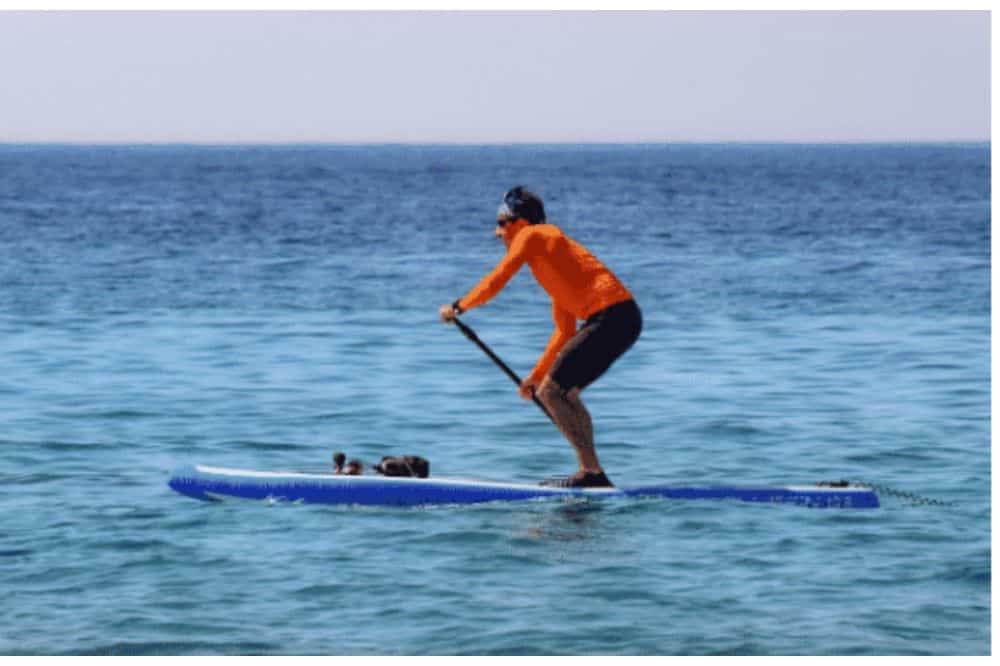
What Is A Racing Paddleboard?
A Racing Paddleboard is explicitly designed for those looking for speed. Their design is crafted to be slim with a keel-shaped bottom and they typically have a displacement hull. As their design is therewith optimized for course stability and efficiency while going straight, they are more challenging to maneuver. Furthermore, they provide less stability compared to other SUP board types, which makes them not an ideal choice for beginners.
Of course, just like with any other type of SUP board, there are various choices to look at and of course sometimes only small differences to other board types like Touring SUP Boards in this case. However, in this article, we focus on Paddleboards which have their main purpose in racing.
Amongst the Racing SUP Boards we distinguish between two main types – sprinting/ long distance aka flatwater and coast runners aka open water race boards.
The difference between the two will have to deal primarily with the shape and size of the boards. Flatwater Race Boards are more efficient in shallow and calm waters as they are designed with a really flat scoop rocker line. Open Water Racers tend to be a little shorter and have a more pronounced scoop-rocker-line in order to prevent the board from diving to heavily in the waves. So the length, as well as the rocker line, helps the boarder to surf within waves. But as always, there are some exceptions: boards for Downwind Racing tend to be 18′ or even longer as this helps to catch long waves and run them fast.
However, as a consequence, you can go with the following rule of thumb: the more choppy the water is in which you’re paddleboarding, the more scoop-rocker-line your board should have.
The difference in the shape between a Flatwater Racing Paddleboard and a more Open Sea Version can be seen by comparing the Naish Javelin with the Naish Maliko.
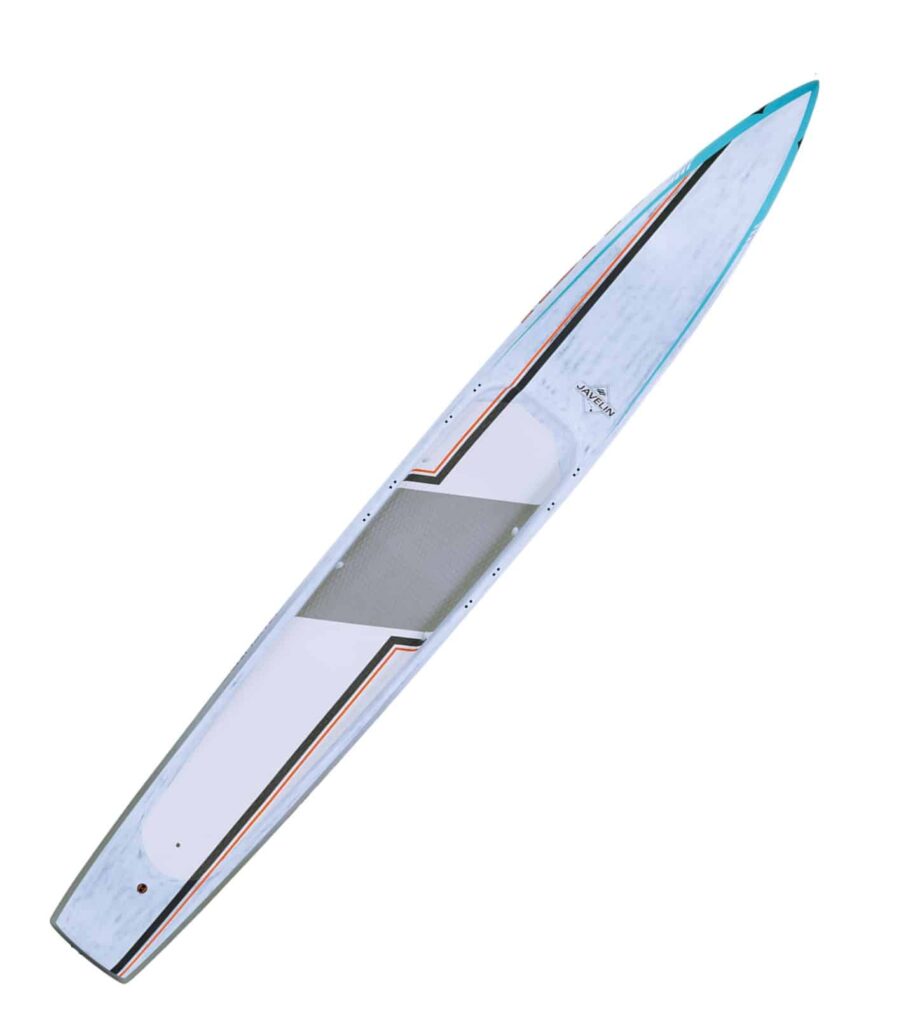
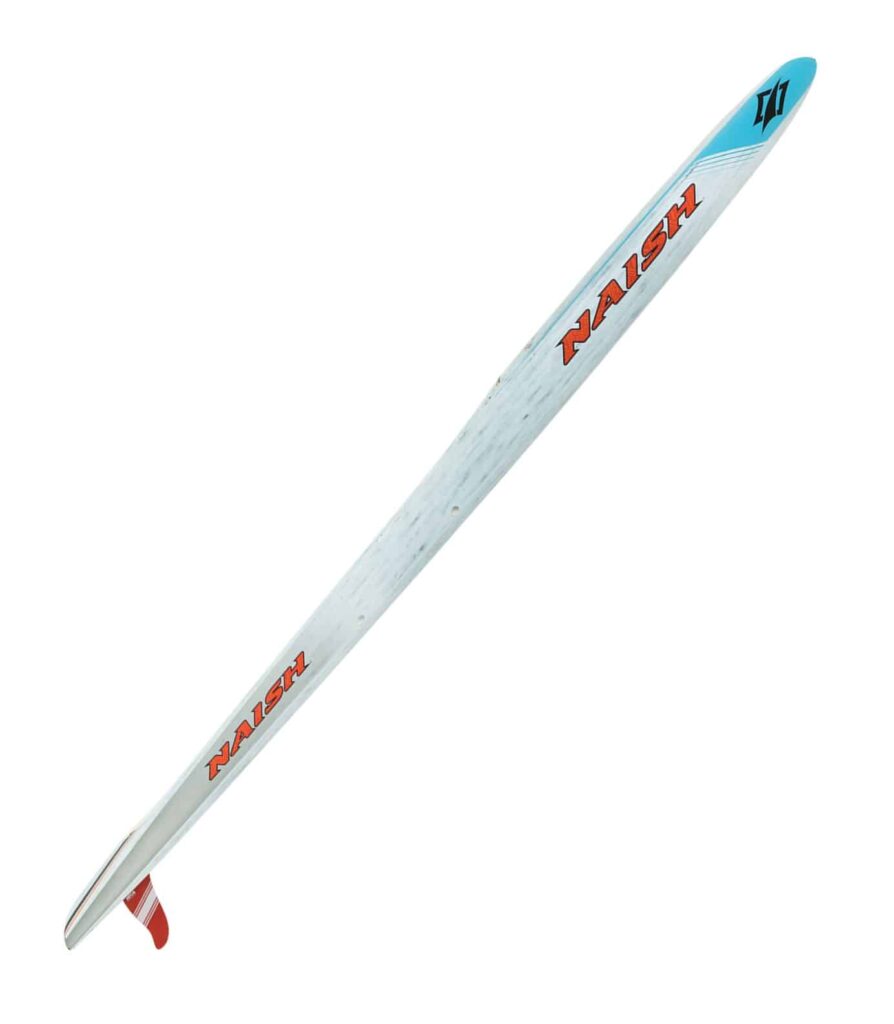
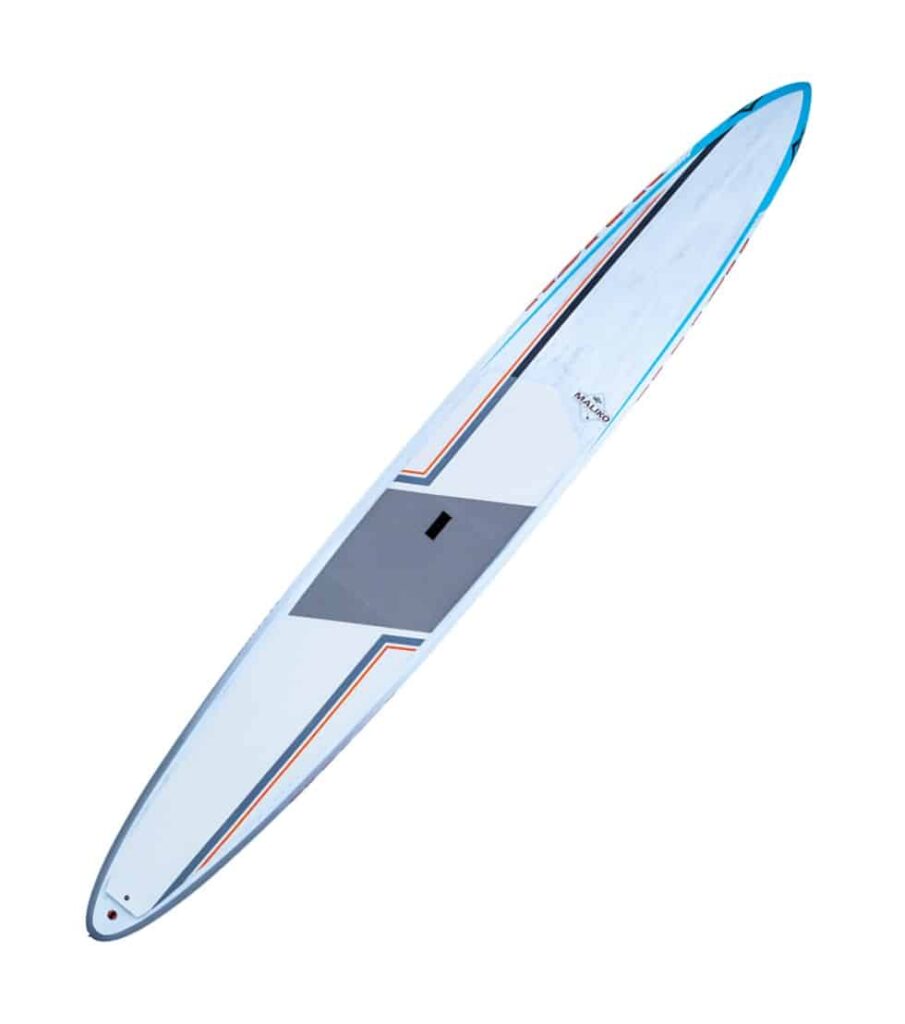
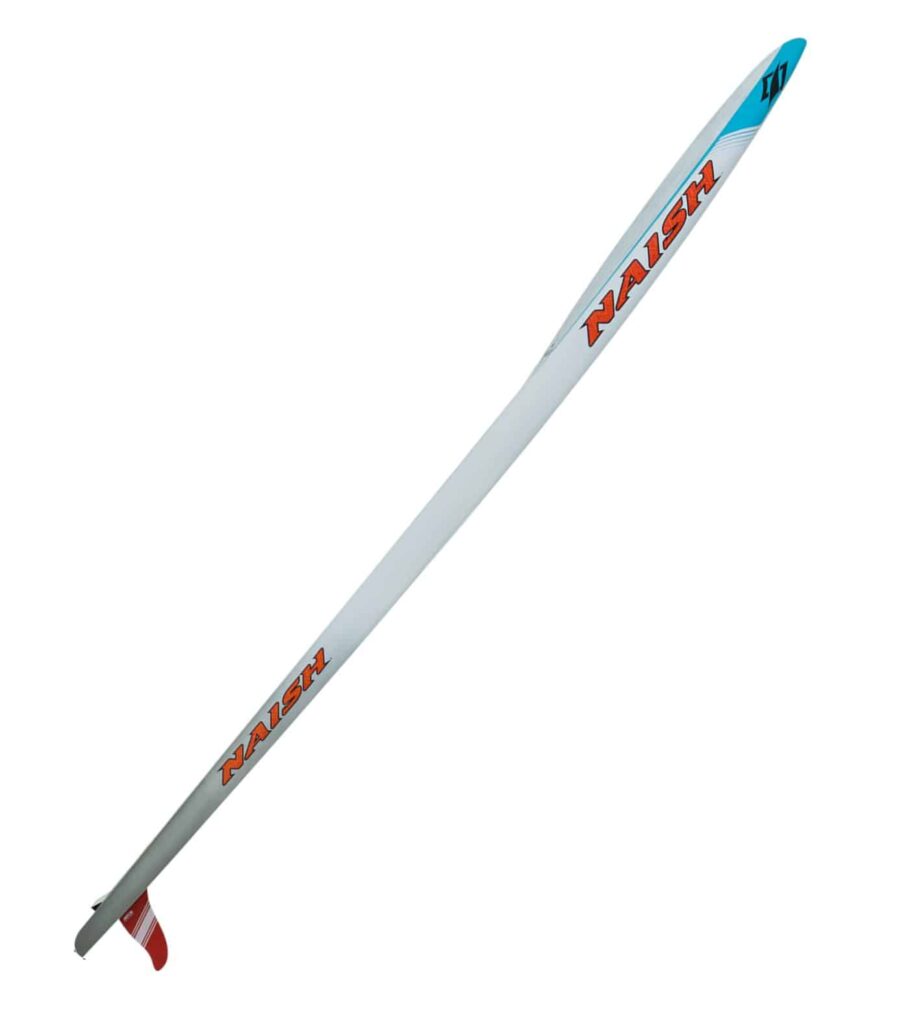
How Much Faster Is A Racing SUP?
Ideally, when looking at a racing SUP, you are trying to find the fastest possible one. But just how much faster is a racing SUP than an average all-around SUP?
There is of course no exact evidence, as the speed difference depends and many factors. However, it is for sure true that a Race SUP is typically (much) more than 50% faster than a normal all-around SUP. Manufacturers like Starboard even claim, that the speed difference between an inflatable Racing Paddleboard and a Race Hardboard can reach up to 20% – 25%!
But as we said above: the actual performance regarding speed, responsiveness, and acceleration depend on many factors like:
- Length
- Width
- Rocker line
- Volume
- Construction Type
- Hull Type
- Fin
All of those factors trade of speed versus maneuverability or stability. This means, that if you plan to find the fastest SUP, you have to choose based on your skill and the type of race you plan to participate in. A great explanation of what to consider and how all the factors play together can be found below.
Is An Inflatable Board Feasible For This Type Of Paddle Boarding?
Yes, inflatable SUPs can be feasible as Race Boards – but only if you’re not searching for the last percentages of performance. So if speed and gliding performance is your single most important requirement, you have to go with a Hardboard. And keep in mind that the difference in speed between a Race iSUP and a Race Hardboard can reach up to 20% – 25%, maybe a little less if you compare to a Race iSUP with Stringers. However, the pure performance difference is still significant.
But why are then inflatable Race Paddleboard developed and produced?
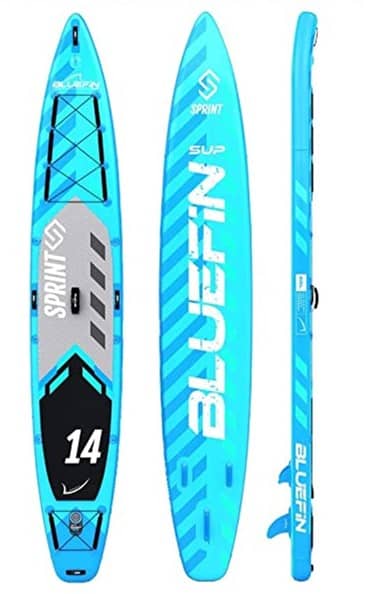
The decision between an inflatable race board and a hardboard basically comes down to performance versus convenience compromise.
As we said above, hardboards deliver far greater performance. The reason is that a hardboard is more rigid than an inflatable board.
However, the big advantage of the inflatable versions is their convenience benefits. You can simply roll them up into a super compact backpack, which makes storage and transport so much easier.
Furthermore, keep in mind that inflatable SUPs are more robust against impacts from rocks, stones, paddles, or other boards. So while carbon fiber or carbon sandwich boards offer a clear speed advantage, they can be much more susceptible to ‘dings’ and cracks.
One of our favorite high-quality inflatable coast runners is the Bluefin Sprint. Even though it is not a pure race machine, it still is a fast board, but provides above average robustness and durability.
Who Are SUP Race Boards For?
When you look at the overall design of a race SUP board, you’re looking at something that is created for speed. This makes it great for races and doing fast pace activities in a straight line.
Unfortunately, the tradeoff is that they are challenging to maneuver and have a reduced level of stability. A beginner might want to opt for a more easily maneuverable, stable, and typically cheaper board like an all-around board to get started. Racing SUPs are intended and best suited for those that are intermediate or advanced boarders.
Anyone looking to have fun out there and do a little racing or really long tours with high speeds should eventually invest in a board specifically designed for that purpose.
Remark: A worthy alternative, which is positioned between a Race SUP and an All-Around SUP and which is great for doing longer tours, are the so-called Touring SUP Boards.
What Else To Consider When Choosing A Race SUP?
Figuring out the type of SUP you are looking to purchase for your racing activities is one aspect of consideration that needs to be decided before investing your hard-earned money. But there are other considerations that you should look at when choosing a race SUP.
Below we will look at a few of them in hopes that we can help you streamline your decision-making process.
Length
Typically, most racing boards lie between the 12 and 14-foot marker, with coast runners being slightly longer. Basically the following applies: the longer the board, the more speed and tracking stability you get, but the SUP Board becomes more challenging to maneuver. As a consquence this means that the longer the board is, the better your paddling technique should be.
Width
Width is one of the factors that play a role in stability. Of course, stability, when you are racing, is a vital part of the process. Most people should look for a board of 23” or higher, especially if you are a new racer. For those with a little more experience, then a narrower option of 21” could be a good fit. The key to choosing a racing board is focusing on stability over speed, which means the width is an important feature to look at.
Hull Type
There are two different types of hull types to consider when looking at racing boards. These two types are planing and displacement.
Displacement
This hull type is crafted with a concave bottom with a narrower design that is perfect for extra speed. There is also more surface area which elevates the stability as well. A displacement hull rides lower in the water than a planing one which gives the ability to cut through the water. Most SUPs of this design have a pointed nose, which also allows the board to cut through the water. This hull is perfect for a racer looking to utilize its board on flatwater or long-distance racing.
Planing
This type of hull is typically flat or convex. These hulls are crafted to glide on the water at high speeds compared to the discplacemen hull boards. The overall design of this hull allows the board to be more maneuverable. These types of hulls are perfect for racers that are looking to combat choppy waters or ocean races.
Construction Type
When you are looking at construction types, you have to choose from hard boards and inflatable SUPs. Hard boards are stiffer, offering more stability and being faster than an inflatable option. Inflatable SUPs offer more convenience. The fact you can deflate it gives it better portability. This means for racers that are looking to be involved in races a long way from home, this might be a better option.
Thickness
Though racing SUPs tend to be thinner than other SUP styles, you still may want to have a thicker board. That’s because the thicker the board, the easier it will move through the water and be able to handle your weight. Though speed is essential, so are stability and stiffness when racing. Ideally, you want to look at a board that is 6 inches or thicker.
Buoyancy
You have to consider buoyancy in combination with your weight. If you weigh less than 200 pounds, you can have your pick of race SUPs. However, if you weigh more than that, you will want to pay attention to the weight capacity. Volume capacity also may play a part in drag, so you want to specifically look at that so that the board is faster and easier to maneuver.
Accessories
Paddles are just as important as the board itself. In fact, using a light and stiff carbon paddle will increase your speed, compared to using a normal aluminum paddle, significantly. So if you decide to invest your money into a Race SUP, you should also be willing to find and invest in a good quality paddle.
Final Thoughts

Racing stand-up paddleboards are explicitly designed to give you speed and comfort. By understanding the construction and design principles behind them, you should be able to find yourself a great option that will meet your needs, preferences, and budget. Hopefully, our look at this variation on the classic stand-up paddleboard has helped you find what you have been looking for.






